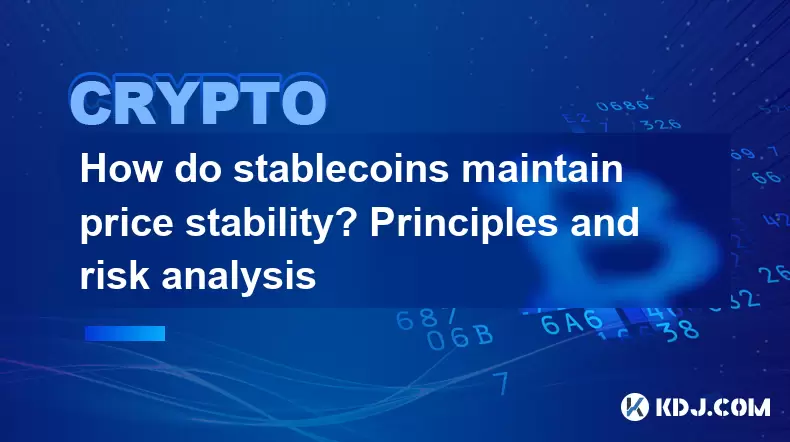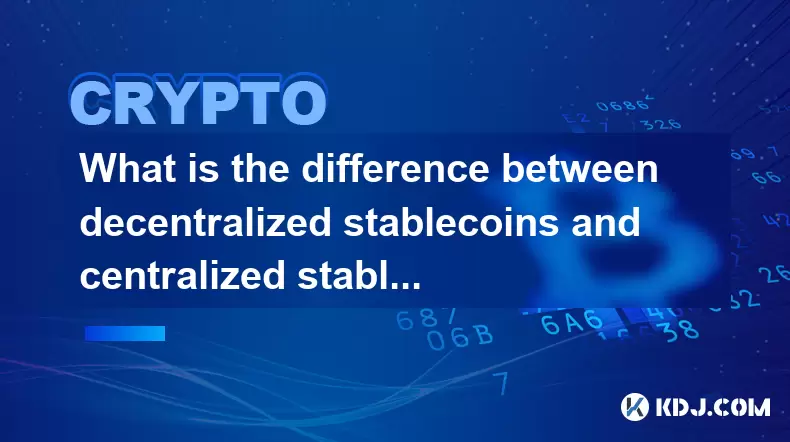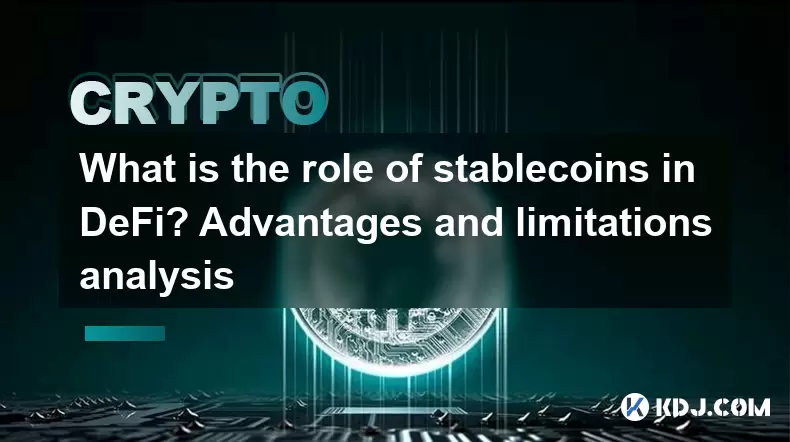-
 bitcoin
bitcoin $124586.364639 USD
0.62% -
 ethereum
ethereum $4670.671710 USD
3.33% -
 xrp
xrp $2.983701 USD
0.18% -
 tether
tether $1.000175 USD
-0.03% -
 bnb
bnb $1209.430642 USD
2.76% -
 solana
solana $231.365861 USD
0.51% -
 usd-coin
usd-coin $0.999665 USD
-0.02% -
 dogecoin
dogecoin $0.264657 USD
4.46% -
 tron
tron $0.346415 USD
1.60% -
 cardano
cardano $0.871586 USD
3.70% -
 chainlink
chainlink $23.451270 USD
7.56% -
 hyperliquid
hyperliquid $46.860071 USD
-2.96% -
 ethena-usde
ethena-usde $1.000120 USD
0.04% -
 sui
sui $3.611279 USD
1.08% -
 stellar
stellar $0.407149 USD
0.96%
How do stablecoins maintain price stability? Principles and risk analysis
Stablecoins maintain price stability through collateralization, algorithms, or hybrid models, offering blockchain benefits without cryptocurrency volatility.
Jun 11, 2025 at 12:01 am

Understanding the Mechanisms Behind Stablecoin Stability
Stablecoins are a category of cryptocurrencies designed to minimize price volatility, often pegging their value to a fiat currency such as the US dollar. The core principle behind stablecoins is to offer the benefits of blockchain technology—like fast and decentralized transactions—while maintaining the price stability typically associated with traditional currencies.
There are several mechanisms through which stablecoins achieve this objective. One of the most common methods involves collateralization, where each stablecoin is backed by reserves of the corresponding fiat currency or other assets. These reserves are held in custodial accounts and can be audited to ensure transparency. This approach is widely used by stablecoins like Tether (USDT) and USD Coin (USDC).
Collateral-Based Models: Fiat and Crypto Reserves
In the fiat-collateralized model, a central entity issues stablecoins after receiving deposits of fiat money. For every unit of stablecoin issued, there must be an equivalent amount of fiat held in reserve. This ensures that users can redeem their tokens for real-world currency at any time, reinforcing confidence in the system.
Another variant is the crypto-collateralized model, where stablecoins are backed by other cryptocurrencies rather than fiat. Since crypto assets are inherently volatile, these systems require over-collateralization to absorb market fluctuations. For example, a user might deposit $200 worth of Ethereum to mint $100 worth of a stablecoin. This excess collateral helps maintain stability even if the value of the underlying asset drops.
Algorithmic Stablecoins: Code-Driven Stability
Unlike asset-backed models, algorithmic stablecoins rely on smart contracts and economic incentives to maintain price equilibrium. These coins do not hold reserves but instead adjust supply dynamically based on demand. If the price of the stablecoin falls below the peg, the algorithm reduces supply by incentivizing holders to burn tokens. Conversely, if the price rises above the peg, new tokens are minted to increase supply and bring the price back down.
This mechanism requires robust governance and trust in the protocol's ability to manage volatility. However, it also introduces systemic risks, especially during periods of extreme market stress when confidence may wane, leading to destabilizing feedback loops.
Risk Factors in Stablecoin Ecosystems
Despite their design intent, stablecoins are not immune to risks. One of the primary concerns is reserve transparency. In cases where a stablecoin issuer fails to maintain adequate reserves or engages in opaque financial practices, the peg can break, triggering panic among users.
Additionally, regulatory scrutiny poses a significant risk. Governments and financial institutions are increasingly focusing on stablecoins due to their potential impact on monetary policy and systemic financial stability. Regulatory actions could impose liquidity restrictions or compliance requirements that affect how stablecoins operate.
For algorithmic stablecoins, the risk lies in reliance on market psychology and investor behavior. A loss of confidence can lead to a death spiral, where selling pressure causes the price to drop, prompting further selling until the peg collapses entirely.
Operational Risks and Smart Contract Vulnerabilities
Beyond macroeconomic and regulatory risks, stablecoins face operational threats, particularly those operating on decentralized networks. Smart contract vulnerabilities can expose funds to hacking or manipulation. Even minor coding errors can have catastrophic consequences, especially in protocols managing large volumes of capital.
To mitigate these risks, developers must implement rigorous auditing processes, use formal verification tools, and conduct regular security assessments. Moreover, multi-signature wallets and timelocks for critical functions can prevent unauthorized changes and provide additional layers of protection.
Users should also exercise caution by choosing stablecoins with transparent governance structures, verifiable reserve audits, and strong community oversight. Trust in the issuing entity or protocol is essential for long-term viability.
Frequently Asked Questions
What happens if a stablecoin loses its peg?If a stablecoin loses its peg, it indicates a breakdown in the mechanisms designed to maintain price stability. This can occur due to insufficient reserves, loss of confidence, or external shocks. When this happens, arbitrageurs may step in to restore the peg, or the system may undergo restructuring.
Can stablecoins be hacked?While stablecoins themselves are built on secure blockchains, vulnerabilities in smart contracts or centralized custodians can make them susceptible to attacks. Proper auditing and transparent reserve management significantly reduce this risk.
Are all stablecoins backed by USD?No, while many stablecoins are pegged to the US dollar, others are linked to different fiat currencies like the euro or yen. Some are also pegged to commodities like gold or other cryptocurrencies.
How do I verify a stablecoin’s reserves?Most reputable stablecoin issuers publish regular attestation reports from third-party auditors. Users can review these documents to confirm whether the circulating supply matches the reported reserves.
Disclaimer:info@kdj.com
The information provided is not trading advice. kdj.com does not assume any responsibility for any investments made based on the information provided in this article. Cryptocurrencies are highly volatile and it is highly recommended that you invest with caution after thorough research!
If you believe that the content used on this website infringes your copyright, please contact us immediately (info@kdj.com) and we will delete it promptly.
- BlockDAG, DOGE, HYPE Sponsorship: Crypto Trends Shaping 2025
- 2025-10-01 00:25:13
- Deutsche Börse and Circle: A StableCoin Adoption Powerhouse in Europe
- 2025-10-01 00:25:13
- BlockDAG's Presale Buzz: Is It the Crypto to Watch in October 2025?
- 2025-10-01 00:30:13
- Bitcoin, Crypto, and IQ: When Genius Meets Digital Gold?
- 2025-10-01 00:30:13
- Stablecoins, American Innovation, and Wallet Tokens: The Next Frontier
- 2025-10-01 00:35:12
- NBU, Coins, and Crypto in Ukraine: A New Yorker's Take
- 2025-10-01 00:45:14
Related knowledge

What is the difference between decentralized stablecoins and centralized stablecoins? Pros and cons comparison
Jun 15,2025 at 09:42am
What Are Stablecoins and Why Do They Matter?Stablecoins are a category of cryptocurrencies designed to maintain a stable value, usually pegged to an e...

What is the role of stablecoins in DeFi? Advantages and limitations analysis
Jun 14,2025 at 06:28am
Understanding Stablecoins in the DeFi EcosystemStablecoins play a pivotal role in the decentralized finance (DeFi) landscape by providing a bridge bet...

How do algorithmic stablecoins work? Potential risks and market impact
Jun 12,2025 at 02:07pm
Understanding Algorithmic StablecoinsAlgorithmic stablecoins are a type of cryptocurrency designed to maintain a stable value relative to a specific a...

How do stablecoins anchor legal currencies? Technical and economic model analysis
Jun 16,2025 at 08:43am
Understanding the Concept of StablecoinsStablecoins are a category of cryptocurrencies designed to maintain a stable value relative to a specific asse...

How do stablecoins maintain price stability? Principles and risk analysis
Jun 11,2025 at 12:01am
Understanding the Mechanisms Behind Stablecoin StabilityStablecoins are a category of cryptocurrencies designed to minimize price volatility, often pe...

What is the operating mechanism of stablecoins? In-depth exploration of its stability principle
Jun 10,2025 at 09:28pm
Understanding the Core Concept of StablecoinsStablecoins are a unique category within the cryptocurrency market, designed to address one of the most s...

What is the difference between decentralized stablecoins and centralized stablecoins? Pros and cons comparison
Jun 15,2025 at 09:42am
What Are Stablecoins and Why Do They Matter?Stablecoins are a category of cryptocurrencies designed to maintain a stable value, usually pegged to an e...

What is the role of stablecoins in DeFi? Advantages and limitations analysis
Jun 14,2025 at 06:28am
Understanding Stablecoins in the DeFi EcosystemStablecoins play a pivotal role in the decentralized finance (DeFi) landscape by providing a bridge bet...

How do algorithmic stablecoins work? Potential risks and market impact
Jun 12,2025 at 02:07pm
Understanding Algorithmic StablecoinsAlgorithmic stablecoins are a type of cryptocurrency designed to maintain a stable value relative to a specific a...

How do stablecoins anchor legal currencies? Technical and economic model analysis
Jun 16,2025 at 08:43am
Understanding the Concept of StablecoinsStablecoins are a category of cryptocurrencies designed to maintain a stable value relative to a specific asse...

How do stablecoins maintain price stability? Principles and risk analysis
Jun 11,2025 at 12:01am
Understanding the Mechanisms Behind Stablecoin StabilityStablecoins are a category of cryptocurrencies designed to minimize price volatility, often pe...

What is the operating mechanism of stablecoins? In-depth exploration of its stability principle
Jun 10,2025 at 09:28pm
Understanding the Core Concept of StablecoinsStablecoins are a unique category within the cryptocurrency market, designed to address one of the most s...
See all articles










































































